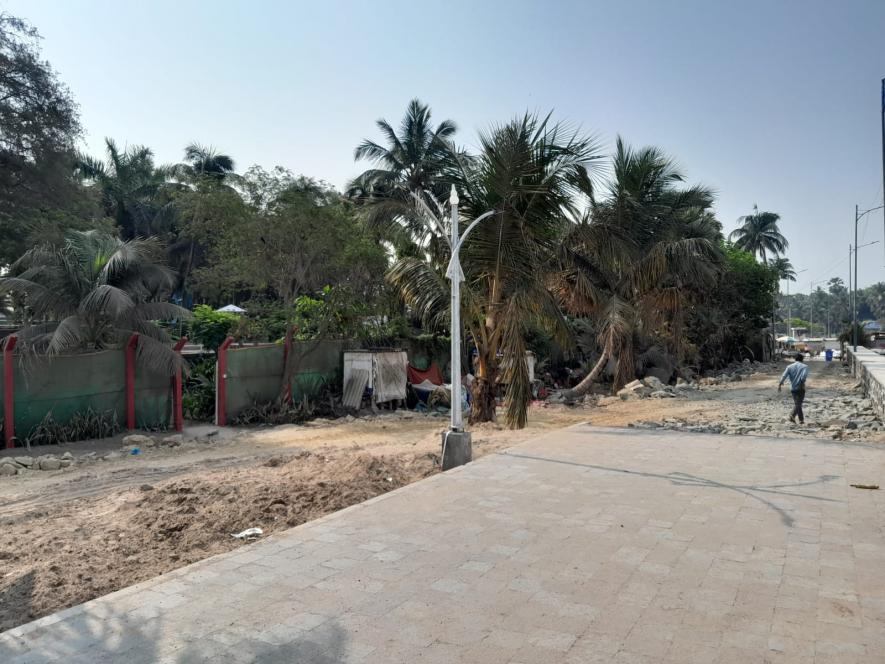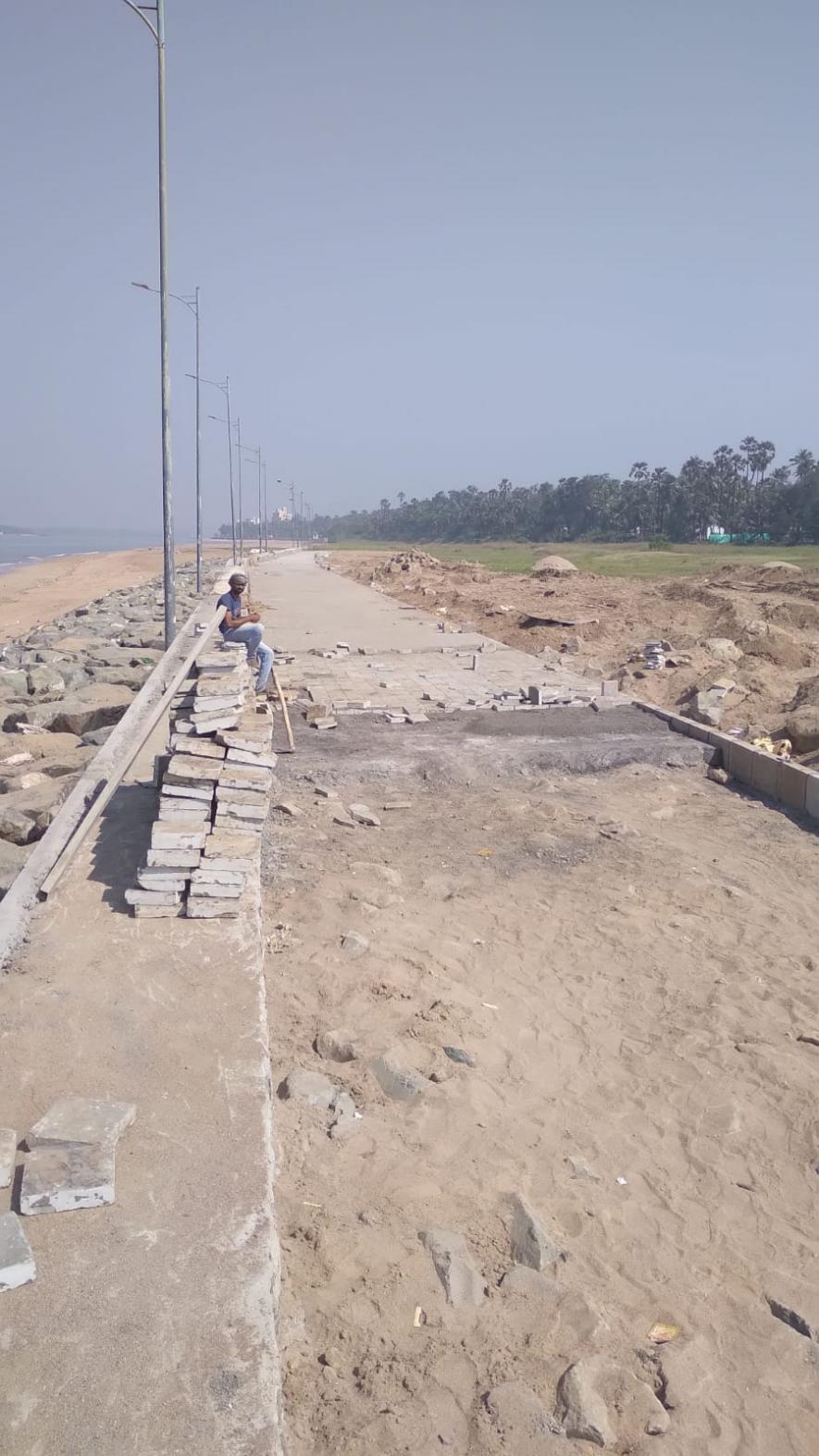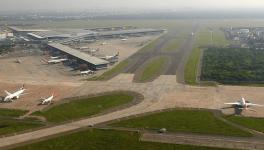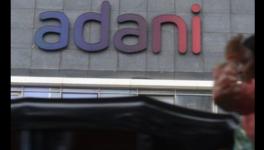Did Maharashtra Govt Violate Environmental Laws in Mumbai’s Aksa Beach Beautification?

Photos: Special arrangement
New Delhi: The Maharashtra government has allegedly violated rules pertaining to the conservation of coastal ecology in the beautification project of a stretch of beach in Malad in suburban Mumbai. As part of the project, the Maharashtra Maritime Board raised a concrete wall in an area along Aksa Beach where allegedly no construction is permissible because it is considered ecologically sensitive.
As per the project proposal that the state government has cleared, the Board, a department tasked with administering and conserving the state’s seacoast, has been permitted only to undertake landscaping activities on the Aksa beachfront. This includes a garden, a play area for children and a recreational ground.
The Board allegedly has no permission whatsoever for the wall’s construction from the Maharashtra Coastal Zone Management Authority (MCZMA). The MCZMA, which ensures the implementation of the Coastal Regulation Zone (CRZ) Notification, 2011, had rejected the proposal for a sea wall six years ago. It also recently rejected proposals for a restaurant, a food plaza and a gym as part of the beautification project.
Environmental activists have alleged that the 600-metre-long wall – which is also wide enough for a four-wheeler to pass through – is being raised within the high tide line in an area categorised as CRZ 1. Any new construction, like a beautification project, is prohibited in CRZ I areas.
“It has been scientifically proven that solid construction raised within high tide lines results in land erosion in other stretches of the sea coast. This wall, which is being constructed in the form of a bund, will obstruct tidal waves. Malad is a densely populated area, and land erosion anywhere along the suburbs’ seacoast will result in disastrous consequences for existing human habitations,” BN Kumar of the not-for-profit environmental organisation NatConnect Foundation told the reporter.
Malad is the most densely populated municipal ward within the Brihanmumbai Municipal Corporation where land erosion, it has been apprehended, might result in losses of lives and livelihoods, particularly of the fishermen communities. Activists have also alleged that the wall will diminish the aesthetic beauty of Aksa Beach, which is popular among tourists for its serenity and cleanliness. In recent times, the calamitous effects of land erosion resulting from manmade activities have been reported from the sea coasts of West Bengal and Kerala.
Environmentalists have also cast aspersions on the Board’s intention to proceed with the project. Aksa Beach is located near Madh Island, which is home to many celebrities and rich businessmen. The purpose of enhancing the area's real estate value by constructing this project has not been ruled out by activists. As per documents, when the proposal to construct a bund was rejected, the Board repackaged it as an “anti-erosion measure” in order to get the necessary approvals.

Photos: Special arrangement
In January 2017, the Board presented a proposal for the first time for constructing a Gabion Wall (a retaining wall made of stacked stone-filled wire-mesh packets) along Aksa Beach. However, the MCZMA asked the Board to explore other options like “ecosystem-based solutions” instead of solid construction.
“The Authority [MCZMA] felt that the beach may be eroded due to solid construction on the beach. Further, solid construction on the beach is not permissible as per the CRZ Notification, 2011. The Authority, after deliberation, decided to reject the proposal from CRZ's point of view,” states the minutes of the MCZMA’s meeting dated January 17-18, 2017.
However, in November 2018, the Board presented a new proposal in which the wall was repackaged as an “anti-sea erosion measure” as part of works to repair an existing “old bund”. The new proposal included the construction of a pathway, the construction of a parapet wall and solar street lighting. The MCZMA noted that the proposed project site was in a CRZ I area. It further took cognisance of the project’s Environment Impact Assessment (EIA) report, as per which the work to be undertaken involved “clearing, stripping and levelling of sites, construction of anti-sea erosion measures, earth filling and excavation for the foundation”, which “will lead to some disturbances to the habitat.”
Nevertheless, the MCZMA recommended the proposal for constructing an “anti-sea erosion bund” to the State Environment Impact Assessment Authority (SEIAA). It imposed certain conditions, however, including a prohibition on construction or debris dumping within the high tide line or the CRZ 1 area. The SEIAA granted final clearance to the project on March 5, 2019.
“There was complete non-application of mind on the part of MCZMA when it recommended the project for CRZ clearance. It chose not to take cognisance of the fact that the proposed project would further exacerbate the issue it was allegedly being built to fix, that is, erosion of the sea beach. Furthermore, No pre-existing sea wall or bund required repair, as was being claimed by the Board,” said Mumbai-based environmental activist Zoru Bhathena.
In a meeting held thereafter on November 24, 2020, the MCZMA received a proposal from the Board for an amendment in CRZ clearance of the “anti-sea erosion measures” for the beachfront development of Aksa. This proposal included a garden for senior citizens and a children’s play area, an entrance and a parking space, a food plaza, lawns and toilets, a gym and a space for yoga, wooden shacks and steps, bamboo sheds and steps, and volleyball courts. The MCZMA asked the Board to present a detailed layout map of the proposal by superimposing it on the approved Coastal Zone Management Plan (CZMP), 2011, on a scale of 1:4000 in order to ascertain the proposed constructions vis-à-vis the CRZ status.
On the basis of a letter submitted by the Board in March 2021, which contained the superimposition of the layout of the project on approved CZMP, 2011 in 1:4000 scale, the MCZMA arrived at the conclusion that the proposed constructions fall in the CRZ II area.
Recommendations were granted by the MCZMA for “landscaping, playground/recreational ground/garden only,” while activities like “plaza/restaurant/gym/wooden shack on the seaward side” were rejected.
“MMB [the Board] to strictly ensure that no construction is allowed on Aksa Beach,” stated the minutes of MCZMA’s meeting held on June 10 and 11, 2021.
Activists have claimed that the entire Aksa Beach is designated as CRZ 1A and CRZ 1B and that no part of the beach has been categorised as a CRZ II area as has been claimed by the Board.
“The beach is pristine and is free from any development whatsoever. The CRZ II area falls beyond the beach area. The proposal illegally seeks to develop Aksa Beach under the garb of being an anti-erosion measure,” said Bhathena.
A questionnaire was emailed to the Board, asking, amongst other queries, to provide a copy of clearance, if any, it has from authorities concerned for raising the solid construction on Aksa Beach. No response had been received at the time that this article was published.
Since construction work commenced on the project in July 2022, activists have knocked on several doors to complain that the wall was being constructed in violation of environmental norms. They have emailed several complaints to Maharashtra’s environment department, the state’s Chief Secretary, the Union Ministry of Environment, Forests & Climate Change (“the ministry”) and the Chief Minister’s Office between July 2022 and April 2023.

Photos: Special arrangement
In March 2023, the ministry asked the MCZMA to review and examine the issue. Five days later, the Board said it had formed an “internal committee to review the status of obtained statutory clearances.” The committee’s report has not been made available to the activists thus far.
In a petition filed with the National Green Tribunal, the activists cited a report prepared by the National Institute of Ocean Technology (NIOT) which had recommended alternative measures for anti-sea erosion measures in Puducherry. The report examined the perils of constructing “hard structures”, such as Gryones and seawalls and the aggravated erosion of the beach caused by such construction. The NIOT had recommended in the report that “soft engineering” approaches like beach nourishment preserve the coastal stretches of the Union territory.
The petitioners have also referred to earlier judgements of the green tribunal that had recommended the replacement of seawalls and Gryones with “softer options” like beach nourishment, sand bypassing, dune planting and offshore submerged reefs in order to adhere to the general principle of “working with nature”.
The writer is an independent journalist.
Get the latest reports & analysis with people's perspective on Protests, movements & deep analytical videos, discussions of the current affairs in your Telegram app. Subscribe to NewsClick's Telegram channel & get Real-Time updates on stories, as they get published on our website.
























